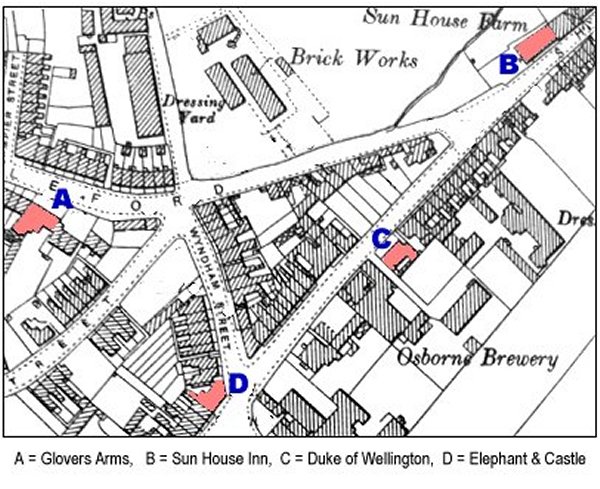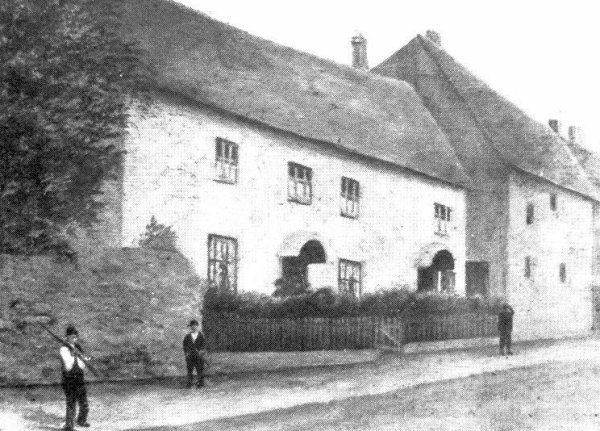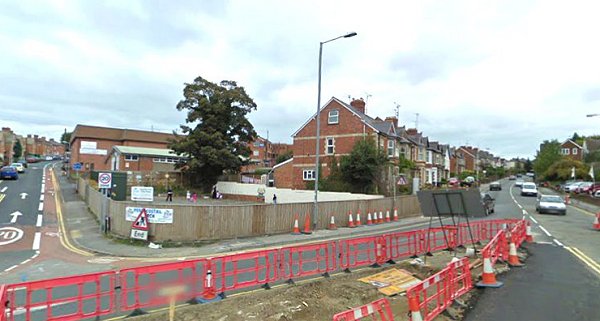the history of yeovil's pubs
PUBS HOME PAGE |
PUBS INTRODUCTION |
PUBS BY NAME |
BEERHOUSES |
sun house inn
London Road (Sherborne Road)
The Sun House
Inn was
originally a
large thatched
17th century
farm house,
located on the
eastern corner
of Southville at
its junction
with London
Road, now called
Sherborne Road.
It is mentioned
in a will of
1717, when it
was left to
Samuel Goodford,
and later in the
Turnpike Trust
minute book of
1753 when it was
noted that the
distance between
Kingston Gate
and Sunhouse was
5 furlongs.
The 1827 Jury List recorded that Charles Foan was a Glover of Sun House, London Road. Apparently a successful glove manufacturer it is suggested that Foan had Osborne House (initially called Penfield House) built around 1830 - he was certainly resident there during the 1830s and 1840s.
On 13 February 1848, the Holy Trinity parish register records that Fanny, Mary Anna and Lydia three children of Benjamin Vincent, were baptised. The address of the family being recorded as living (presumably lodging) at Sun House.
The census and other records show that Sun House traded as an inn from possibly 1803 until at least 1871. The building was demolished about 1910 and the site is now a church car park.
However, the story of the Sun House Inn is somewhat complex and actually two buildings have been frequently confused in the past - Sun House and the Sun House Inn - so a little unraveling of the facts seems appropriate at this juncture.
Leonard Hayward's notes recorded W Phelps as a brewer at Townsend, Sun House in 1803. This was, presumably the father of the William Phelps recorded as being born around 1803 and being listed as a brewer in the 1830's. The next record, Pigot's Directory of 1830, lists Robert Tytherleigh as a brewer at Townsend and this was probably at least twenty years before the Royal Osborne Brewery started up. In fact Robert Tytherleigh either bought or, more likely inherited from his older brother Thomas, the fields known as Pen Field, Pen Hill and Higher and Lower Pen (in fact pretty much the whole of today's Wyndham Hill from the Sherborne Road to the River Yeo) some time after 1829. The lands were sold by his widow in 1835 which, at this time also included "A Messuage or Dwelling-House, with a Shop adjoining in front, also a Brew House, Malt-House, Bake-House, Store-House, Yard, Garden, Orchard and Premises, to the same adjoining and belonging, containing about 1 Acre, situate at the Eastern entrance of the beautiful and flourishing Town of Yeovil, and now in the possession of Mrs Tytherleigh the Widow, having every convenience for the Brewing, Malting, and Baking Businesses."
The records then revert to William Phelps. This is where there has been some later confusion between the house called Sun House and the Sun House Inn that started as a beerhouse at Townsend, London Road run by Charles Blake and the fact that William Phelps and Charles Blake then appear to alternate as licensees at the Sun House Inn has further clouded the issue.
It seems clear (to me, at least) that William Phelps senior was brewing as early as 1803, but whether or not the produce was being sold for consumption on or near the premises is a matter for conjecture. In fact we know that the actual brewing was carried out on the other side of the road from the Sun House and in the 1846 Tithe Apportionment is described as "Brewery and Garden" (Parcel 521) measuring 0a 1r 26p (see note at bottom of page). Owner James Ellis, Occupier William Phelps. Arable." This is shown on the 1842 Tithe Map on the London Road (Sherborne Road) opposite Sun House as a narrow strip of land flanked on the west by a 'withey bed'. Phelps also occupied cottages and gardens separated from London Road by the withey bed and 'Old Nursery'. However William Phelps' brewery was not the forerunner of the later Royal Osborne Brewery.
It is logical to conclude that William Phelps senior retired or died around 1830 and the brewing was taken on by Robert Tytherleigh who was clearly just the brewer and not the owner of Sun House. By 1832 William Phelps junior had become the owner of Sun House as witnessed by the Yeovil Poll Books of 1832 and 1834. William was listed as a brewer in the 1840 Somerset Gazette Directory and in the 1841 census. This, of course, leaves Charles Blake the beer retailer in Robson's Directory of 1839, reappearing as a beer retailer throughout the 1850's in various directories but two records, the 1841 census and Harrison, Harrod & Co's 1859 Directory, specifically locating him in the Sun House Inn.
It appears that William Phelps of Sun House confined his activities to brewing while Charles Blake was a licensee selling beer at the Sun House Inn - a separate property.
Other than
that mentioned
above, I could
find no mention
of Robert
Tytherleigh in
the records.
The Sun House
Inn does not
appear in the
records after
1872 and
presumably
ceased trading
as an inn at
this time. It
was demolished
around 1910.
The last licensee was Mark Langdon who applied for a license to the Borough Petty Sessions in September 1872 but the license was refused. The Western Gazette also gave the following report from the same Petty Sessions proceedings "PC James Clark was summoned for assaulting Mrs Langdon, of the Sun House Inn, on Sep. 5. The constable heard complainant beating her son rather unmercifully at about 11pm and went into the house. He took away the stick she was using. It was alleged that he pushed and struck her, injuring her breast. Complainant called her son to support her statement, and also stated that defendant was drunk. Several witnesses were called for the defence and the case was dismissed."
![]()
William Phelps was born in Somerset around 1803 and was almost certainly the son of William Phelps senior, brewer of Sun House. Clearly by 1832 William actually owned Sun House, as evidenced by the Yeovil Poll Book of that year. In the 1841 census William is listed at Towns End Sun House with his wife, Mary Ann, and their children; Mary, James, Agnes and Robert. William's occupation was listed as "brewer etc." although whether or not the "etc." meant vendor is unclear. William was not to stay at the Sun House for long however and by 1846 he was living in Kirkby Lonsdale, Westmorland, but still owned freehold property in George Lane (presumably George Court?), Yeovil as evidenced by the Yeovil Poll Book of 1846. The 1851 census lists him at Kirkby Lonsdale with Mary and all four children. His occupation was given as solicitor's clerk. Ten years later and his life had taken another turn as the 1861 census listed him as a gentleman living in Kensington, London, with Mary Ann and two of their children; Agnes and Robert. Mary Ann died a year or two later and in 1871 William, now a 64-year old widower, was living with his unmarried daughter, Mary, in Lambeth, London where he described himself as a gentleman landowner. William died in Lambeth in the spring of 1877, aged about 74.
Charles Blake was born about 1799 in Yeovil. He was recorded as a beer retailer in Robson's Directory of 1839 and it is confirmed in the 1841 census that he was living in the Sun House Inn, probably selling beer brewed at the Sun House brewery - a brewery tap if you will. In the 1851 census he was listed with his wife, Hannah, as an innkeeper at 16 London Road, undoubtedly the Sun House Inn although not named as such. Nevertheless he was recorded as the licensee of the Sun House Inn in Harrison, Harrod & Co's 1859 Directory. In the 1861 census Charles and Hannah were living next door to the Sun House Inn and Charles gave his occupation as bricklayer. Both Charles and Hannah were aged 62 and living with them was a 13-year old servant, Emma Adams. Hannah died in the spring of 1864 and a couple of months later Charles married Mary Ann Dark, thirty years his junior. In the 1871 census Charles and Mary were living in Kiddles Lane (now Eastland Road) with Mary's mother, also Mary Ann, as housekeeper. Charles was two years older than his mother-in-law! Charles died in the winter of 1875.
Robert Connick was born about 1814 at Bradford Abbas, Dorset, a mile or two south of Yeovil. At a Petty Sessions in 1860 he applied for a spirits license - which was refused even though he stated to the Magistrates that he had been a policeman for sixteen years and was "receiving a pension of £27 a year in consideration of his services". I found him in the 1861 census where he was listed with his Yeovil-born wife Maria, living at the Sun House Inn. Robert gave his occupation as public house keeper. He died in Yeovil in the summer of 1866 aged about 52.
In 1869 William Houghton "of Sun House" was summoned under the new Beerhouse Act for having his house open for the sale of drink during prohibited hours, on Sunday 8 August. He was fined £1. In October the same year at the Petty Sessions the Bench refused his application for a license renewal "on the ground that applicant had failed to produce satisfactory evidence as to his character". Interestingly, in its edition of 9 April 1869, the Western Gazette in reporting the proceedings of the Borough Petty Sessions, noted "Mr Glyde applied, under the provisions of the "Act to Amend the Law relating to Divorce and Matrimonial Causes in England" for legal protection on behalf of Mrs Houghton, of the Sun House Inn, whose husband who was alleged to have deserted her, and gone to Jersey. The bench declined, for the present, to grant the application, on the ground that the alleged desertion was of too recent a date."
Henry Firkins was born in Shoreditch, London, about 1844, the son of kid skin dyer Charles Firkins of Worcestershire and his wife, Mary, née Barnett. In the 1851 census Henry was living with his parents and seven siblings in Battersea, London and ten years later in Newington, London, at which time Henry was a skin dyer like his father. In April 1865 he married Melena Jeanes in Yeovil and it is in the following census, in 1871, that Henry and Melena were living at the Sun House Inn where Henry, at the age of 26, was listed as inn keeper. They clearly didn't stay long as by 1881 they were living in Northampton. Apparently Henry left Melena and 'married' Henrietta with whom he had seven children. Henry died in Edmonton, north London, in 1918 and Melena died in 1923.
Mark Langdon was born in Bradford Abbas, just south of Yeovil, about 1836, the son of flax worker George Langdon and his wife, Ruth. In the 1841 census Mark was living at Bradford Abbas with his parents and five siblings. By 1851 the family had moved to Stoford, just south of Yeovil, and Mark was working as an agricultural labourer. In 1857 Mark married Sherborne-born Emily Pamela Garrett in Yeovil and in the 1861 census Mark and Emily, together with baby son George and Emily's brother and his wife were at No 3 Newton Farm House where Mark worked as a mason. The family moved to Bond Street and in the 1871 census were listed next door to the Seven Stars Inn with new son, Fred, and Mark's widowed mother, Ruth. Mark was working as a labourer, Emily as a seamstress and 13-year old George was a carpenter's apprentice. The following year Mark was listed as a beer retailer in London Road in Kelly's Directory - but this is the only reference to this venture as by 1881 Mark, Emily and new son Lyndall were living on Reckleford at the junction with Mary Street and Mark, once again, was occupied as a mason. They were still there ten years later when Mark listed his occupation as a builder. Living with him and Emily were two sons, Frederick and Ernest, daughter Alice and grandson Fred. In the 1901 census Mark was listed on Reckleford Hill working as a stone mason and Emily was absent on census night but his two grandsons, George and Fred were present. Mark died in the spring of 1904 aged about 68 and Emily died in the spring of 1912 aged 74.
map

gallery

Sun House Farm in London Road (Sherborne Road) near its junction with Reckleford, the later Sun House Inn. This is a photograph of an oil painting by SW Good, about 10" by 8".

A more familiar view of the site of the Sun House Inn in 2009, during the roadworks. This photograph looks up Southville at left and the Sherborne Road (the old London Road) at right. The site of the Sun House Inn is the car park cum playground behind the fence left of centre at the junction of the two roads.
licensees
1803 – W
Phelps – Brewer
(Notes of LC
Hayward) listed
at Townsend, Sun
House
1830 – Robert
Tytherleigh –
Brewer (Pigot's
1830 Directory -
Brewers) at
Townsend
1832 – William
Phelps (Yeovil
Poll Book)
qualified by
owning freehold
house -
Sun-house,
in this
parish
1834 – William
Phelps (Yeovil
Poll Book)
qualified by
owning freehold
house -
Sun-house,
in this
parish
1839 – Charles
Blake – Beer
Retailer
(Robson’s 1839
Directory)
1840 – William
Phelps – Brewer
(1840 Somerset
Gazette
Directory -
Brewers) of
Middle Street
1841 – William
Phelps – Brewer
(1841 census)
listed as Sun
House
1841 – Charles
Blake – Brick M(aker)
(1841 census)
listed as Sun
House Inn,
London Road
1846 – William
Phelps of Kirkby
Lonsdale (Yeovil
Poll Book)
qualified by
owning freehold
house
in George
Lane
1851 – Charles
Blake –
Innkeeper (1851
census) pub not
named, but at 16
London Road
1850 – Charles
Blake (Hunt & Co
1850 Directory -
Beer Retailers)
listed in London
Road
1852 – Charles
Blake (Slater's
1852 Directory -
Retailers of
Beer) listed at
Townsend
1859 – Charles
Blake (Harrison,
Harrod & Co 1859
Directory)
listed as Sun
House
1860 – Robert Connick
– Spirit license
refused (Petty
Sessions)
1861 – Robert
Connick – Public
House Keeper
(1861 census)
listed as the
Sun House Inn
1861 – Robert
Connick – Beer
Retailer
(Kelly's 1861
Directory)
1866 – Robert
Connick – Beer
Retailer
(Kelly's 1866
Directory)
1869 – William
Houghton – fined
for out of hours
sales
(Borough Petty
Sessions,
September)
1869 – William
Houghton –
License refused
(Borough Petty
Sessions,
October)
1870 – Henry
Firkins –
Refused sprits
license (Borough
Petty Sessions) Sun House
Inn
1871 – Henry
Firkins – Inn
Keeper (1871
census) listed
as the Sun House
Inn
1872 – Mark
Langdon – "of
the Sun House
Inn" licence
refused (Petty
Sessions)
Note
0a 1r 26p = 0
acres, 1 rood,
26 perches.
30.25 square
yards = 1 square
perch, 40 square
perches = 1
rood, 4 roods =
1 acre.